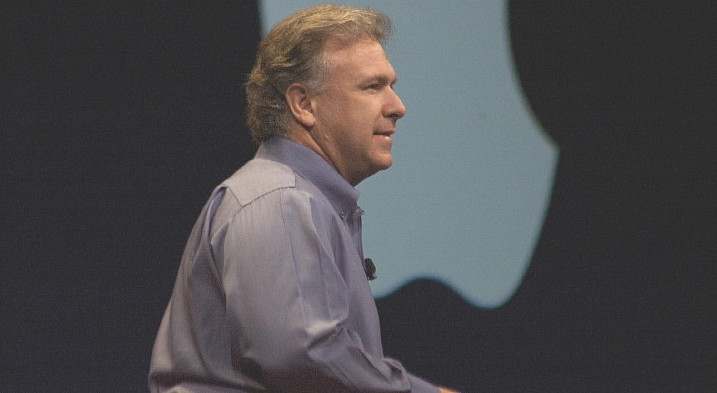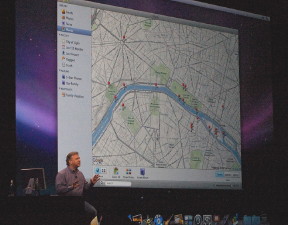|
|

Schiller had an unenviable task as he has some large shoes to fill. With Apple moving on from MacWorld after this, one blogger tried to drum up support for a no-applause response and there were people handing out "Bring back Steve Jobs" leaflets on the approach to the Moscone Center. As much as we love the Steve Jobs showmanship, there is more to Apple than this, particularly now that the groundwork has been laid so extensively. In the 90s when Jobs returned via the NeXt backdoor, the company was a mess. That is not the case now. When he appeared on stage, there was a moment when Phil Schiller looked a bit tense. The moment he began speaking it was clear that he was in charge of the proceedings and set out the program with a strong and confident presentation, announcing that there were to be three new products. There may not have been as much as the mainstream wanted, but some clever groundwork was laid. Schiller began by featuring some of the new Apple stores opened in the last twelve months, which he suggested highlight brand identity. With 3.4 million visits each week to these stores, that equates to 100 MacWorlds each week. Thus he justified the reasoning behind the end of Apple's involvement in MacWorld after this year. He claims that after the solid sales of iPods in the last few years, there has been a Mac resurgence, with some 9.7 million sold last year: growing two times as fast as the rest of the industry.
Faces uses face-detection to identify a person in a photograph. Images identified, can be added with a keyword to create a smart album. Any more photographs of that person in the library are added. Coupled with this is face-recognition software that identifies photographs that may be of the person already in the library and allows a user to confirm this. It is also easy to use this to create a smart album of a family by selecting a group of faces. Places organises images according to where they were taken and includes software that uses geotagging (identifying the co-ordinates where a picture was taken that is included in some new digital cameras). This links to Google maps and a map is displayed in iPhoto, complete with pins. If a photograph is not geotagged, there is a new field in Events for the location to be added by the user and iPhoto then adds a geotag. This feature in iPhoto also supports Facebook and Flickr: there are icons on the toolbar for these online services and, with Facebook for example, it is possible to synchronise with others using the service.
Last year's iMovie made it easier to make movies, but left many unhappy as some older features had been omitted. Some of those missing features, particularly with regard to editing, have been added or improved. It is now possible to edit using a timeline. There is advanced drag and drop of clips, several new themes are included and there are animated travel maps to show where one has been. A well-received, final feature was video stabilisation. The new iMovie was demonstrated by Randy Ubillos, developer of the previous version. He showed the flexibility iMovie now has with the way it can easily edit both clips and audio separately, giving a user professional capabilities with a simple interface. When he showed how a shot from a moving jeep could be stabilised, thus enhancing the images filmed, there was considerable appreciation.

Phil Schiller returned to talk about Garageband which has an exceptional new feature, called, "Learn to Play". This gives a new interface of the instrument, the instructor and controls. The software comes bundled with nine basic guitar and piano lessons, however there are also Artist Lessons which can be downloaded for $4.99 each, featuring major recording artists explaining how each wrote a specific song and teaching that to the student in Garageband. Among the artists so far are John Fogarty (Proud Mary), Collie Caillat, Ryan Tedder of One Republic, Norah Jones and Sting. The new version of iLife is to be available from late January and will cost $79. As before it will also come bundled with all new Macs.
Keynote Remote is a new app available for $0.99 from the App Store for the iPhone or iPod touch which allows the presentation, including a display of slides showing and to come, to be controlled from the device. Pages has considerably more focus on use as a word processor. Several features for non-media professionals have been added, like full screen view and a dynamic outliner for control of the organisation of a piece of writing. Mail Merge has been beefed up to work with Numbers, the spreadsheet software, while there is now support for MathType and EndNote integration, which will please academic writers, particularly in the science and engineering fields. [That support is in each of the iWork components.] Numbers has added table categories and easier formula writing including a search feature with a clear interface; there are new chart options, particularly of benefit to scientific and financial fields; and there are linked charts: if the data is changed in Numbers, a chart used in Pages, for example, will also be updated. The update to iWork is $79, with a $99 Family Pack. It is $49 with a new Mac and there is also a box set of iLife, OS X and iWork for $169. iWork is available immediately. Schiller also outlined a new service at iwork.com which allows sharing and collaboration of documents online, so that it is not necessary to use email when seeking comments. In his demo of this he used Pages, but Numbers and Keynote may also be used. It looked similar to the interface in the Mobile Me Gallery. Viewing may be in any modern browser and he mentioned Safari, Firefox and Internet Explorer. Documents can be downloaded if needed in iWork formats. PDF and DOC are also available. Initially, perhaps after the lessons of Mobile Me, the service is a beta, although will later be subscription.
With the slightly longer sides, there are three USB ports available. It has the same glass trackpad as the other notebooks and can handle up to 8G RAM: it comes with 4G. The standard processor is 2.66GHz although the 2.93GHz Core 2 Duo is an option. There are two graphics processors like in the latest MacBook Pro 15". One of the most important new features is the lithium-polymer battery which provides up to 8 hours of life: a 60% increase. Like the installation in the MacBook Air, this is not removable by the user and has to be changed by the distributor although battery life has been considerably increased: it is now up to 1,000 cycles which is expected to be around 5 years. The last Keynote presentation from Apple, ended with Tony Bennet, the veteran performer who began with "The Best is Yet to Come" and ended with his "I Left my Heart in San Francisco." Perhaps two messages for Apple followers. Those who are not yet users of Apple products (particularly iWork and iLife) may miss the point. The emphasis on software services means higher future generation of income from increased use of those services. Despite the lack of galvanising products, this was a job well done by Phil Schiller.

|
|

 The first of his new products was iLife09, with new versions of iPhoto, iMovie and Garageband, which were featured in the presentation, plus iWeb and iDVD. Schiller began with iPhoto09 which has some exceptional new features. "Events" was a new method of organising images introduced with the last version. Now Apple has added "Faces", which organises photographs using people, and "Places".
The first of his new products was iLife09, with new versions of iPhoto, iMovie and Garageband, which were featured in the presentation, plus iWeb and iDVD. Schiller began with iPhoto09 which has some exceptional new features. "Events" was a new method of organising images introduced with the last version. Now Apple has added "Faces", which organises photographs using people, and "Places". There was much applause for these new features and this increased when Phil Schiller showed a couple of the new slideshow themes, which put dramatic slideshows in the reach of ordinary Mac users. There are also new book themes, plus the added feature of including maps in a book, with pins to show a photograph's location. When he switched to demo mode, it was clear that he had done his homework. Like Jobs, he knew the product thoroughly and had clearly rehearsed. It was a smooth and professional demo.
There was much applause for these new features and this increased when Phil Schiller showed a couple of the new slideshow themes, which put dramatic slideshows in the reach of ordinary Mac users. There are also new book themes, plus the added feature of including maps in a book, with pins to show a photograph's location. When he switched to demo mode, it was clear that he had done his homework. Like Jobs, he knew the product thoroughly and had clearly rehearsed. It was a smooth and professional demo.